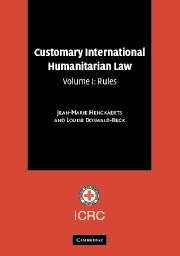Book contents
- Frontmatter
- Contents
- Foreword by ICRC President Jakob Kellenberger
- Foreword by Judge Abdul G. Koroma
- Foreword by Yves Sandoz
- Acknowledgements
- Introduction
- List of abbreviations
- Part I The Principle of Distinction
- Part II Specifically Protected Persons and Objects
- Chapter 7 Medical and Religious Personnel and Objects (Rules 25–30)
- Chapter 8 Humanitarian Relief Personnel and Objects (Rules 31–32)
- Chapter 9 Personnel and Objects Involved in a Peacekeeping Mission (Rule 33)
- Chapter 10 Journalists (Rule 34)
- Chapter 11 Protected Zones (Rules 35–37)
- Chapter 12 Cultural Property (Rules 38–41)
- Chapter 13 Works and Installations Containing Dangerous Forces (Rule 42)
- Chapter 14 The Natural Environment (Rules 43–45)
- Part III Specific Methods of Warfare
- Part IV Weapons
- Part V Treatment of Civilians and Persons Hors De Combat
- Part VI Implementation
Chapter 11 - Protected Zones (Rules 35–37)
Published online by Cambridge University Press: 05 June 2012
- Frontmatter
- Contents
- Foreword by ICRC President Jakob Kellenberger
- Foreword by Judge Abdul G. Koroma
- Foreword by Yves Sandoz
- Acknowledgements
- Introduction
- List of abbreviations
- Part I The Principle of Distinction
- Part II Specifically Protected Persons and Objects
- Chapter 7 Medical and Religious Personnel and Objects (Rules 25–30)
- Chapter 8 Humanitarian Relief Personnel and Objects (Rules 31–32)
- Chapter 9 Personnel and Objects Involved in a Peacekeeping Mission (Rule 33)
- Chapter 10 Journalists (Rule 34)
- Chapter 11 Protected Zones (Rules 35–37)
- Chapter 12 Cultural Property (Rules 38–41)
- Chapter 13 Works and Installations Containing Dangerous Forces (Rule 42)
- Chapter 14 The Natural Environment (Rules 43–45)
- Part III Specific Methods of Warfare
- Part IV Weapons
- Part V Treatment of Civilians and Persons Hors De Combat
- Part VI Implementation
Summary
Rule 35. Directing an attack against a zone established to shelter the wounded, the sick and civilians from the effects of hostilities is prohibited.
Practice
Volume II, Chapter 11, Section A.
Summary
State practice establishes this rule as a norm of customary international law applicable in both international and non-international armed conflicts.
International and non-international armed conflicts
The First and Fourth Geneva Conventions provide for the possibility of setting up hospital and safety zones, and a draft agreement for the establishment of such zones is attached thereto. In addition, the Fourth Geneva Convention provides for the possibility of setting up neutralised zones. Both types of zone are intended to shelter the wounded, the sick and civilians from the effects of conflict, but the hospital and safety zones are meant to be far removed from military operations, whereas neutralised zones are intended for areas in which military operations are taking place.
The relevant provisions of the Geneva Conventions are incorporated in many military manuals, which emphasise that these zones must be respected. Under the legislation of several States, it is an offence to attack such zones.
In a resolution adopted in 1970 on basic principles for the protection of civilian populations in armed conflicts, the UN General Assembly stated that “places or areas designated for the sole protection of civilians, such as hospital zones or similar refuges, should not be the object of military operations”.
- Type
- Chapter
- Information
- Customary International Humanitarian Law , pp. 119 - 126Publisher: Cambridge University PressPrint publication year: 2005
- 1
- Cited by

